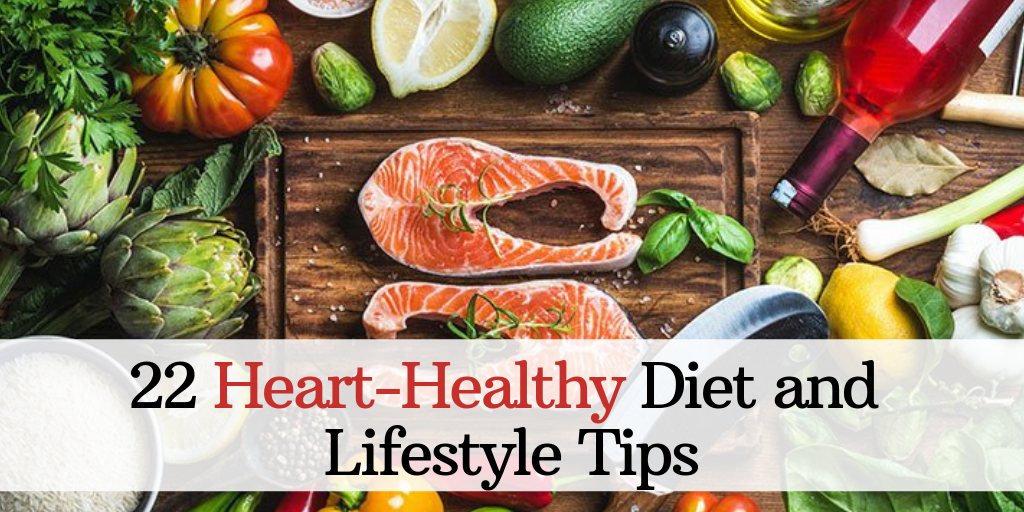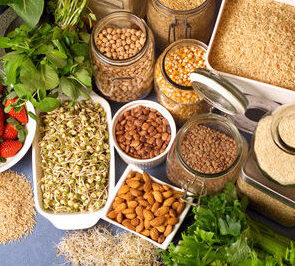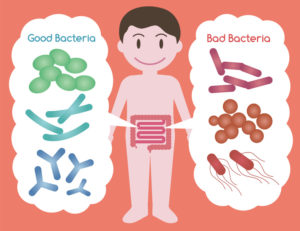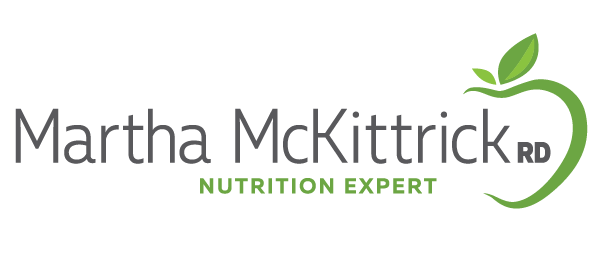26 Heart-Healthy Diet and Lifestyle Tips

Updated 2/22/21 Heart disease is often thought as disease for older men. But it’s actually the number #1 killer of women! And people with diabetes, insulin resistance and PCOS – all my specialties – have an even greater risk of heart disease. Most of us don’t think about eating for heart health, We’re too busy juggling work, family, social obligations – or the hottest diet  trend – to think about our hearts. The good news is that about 80 percent of all cases of cardiovascular disease are preventable. So in honor of American Heart Month, read on to get my top 22 heart healthy diet and lifestyle tips.
trend – to think about our hearts. The good news is that about 80 percent of all cases of cardiovascular disease are preventable. So in honor of American Heart Month, read on to get my top 22 heart healthy diet and lifestyle tips.
Heart health nutrition recommendations have changed
I’m showing my age here! But when I first started practicing in the field of nutrition, it was all about limiting fat as much as possible. We were fat phobs! And margarine was good and eggs were bad! Sugar wasn’t associated with heart disease. Hello crappy fat free snacks like Snackwells! But fast forward to 2019 and things have changed A LOT! We know that added sugar in excess has many negative health effects, eggs are out of the hot seat and not all fat is bad. On the contrary, the Mediterranean diet which is ~ 40% fat is one of the healthiest diets we can eat. We also know heart health is more about dietary patterns than villainzing single nutrients (ie. cheese, meat, butter).
What Does the average American eat?
So what does the average Joe eat and how does this compare to the heart health recommendations? Put it this way …  we aren’t looking too good! The majority of Americans don’t consume adequate fruits, veggies, whole grains or fiber. And we’re eating too many ultra-processed foods, added sugar and sodium. So what should you do? I’d suggest you start by keeping a food log for a week or so to get a baseline. Then check out my tips below. Pick 1-3 goals to work on. Once you feel you can make them a part of your diet/lifestyle, move on to another goal.
we aren’t looking too good! The majority of Americans don’t consume adequate fruits, veggies, whole grains or fiber. And we’re eating too many ultra-processed foods, added sugar and sodium. So what should you do? I’d suggest you start by keeping a food log for a week or so to get a baseline. Then check out my tips below. Pick 1-3 goals to work on. Once you feel you can make them a part of your diet/lifestyle, move on to another goal.
22 Heart Healthy Diet and Lifestyle Tips
DIET
 Increase your intake of fruits and vegetables:
Increase your intake of fruits and vegetables:
76% of Americans don’t meet the goal for fruit and 84% don’t meet the goal for vegetables.
Goal: least 4.5 cups a day. Most of us aren’t even close to this. Eating on the run makes eating veggies especially challenging! Check out my previous post on heart healthy snacks.
Health benefits:
-Provide essential vitamins, minerals, antioxidants, phytonutrients, and fiber to help fight chronic diseases, including stroke and perhaps other cardiovascular diseases and certain cancers
-Aid in gastrointestinal health
-Aid with weight control
-Many vegetables contain prebiotics (substances that feed the good bacteria in our gut- which may aid in heart health)
Tips to increase: Add berries to oatmeal, cereal, smoothies or yogurt, keep cup up veggies on hand to snack on, add veggies to omelets, soups, salads. Make sure to have a big portion of vegetables every dinner. Grab a fruit for an afternoon snack. Read my blog post on top 22 ways to add in vegetables and fruits.- Increase your intake of fiber rich foods.
We consume an average intake of 15 grams of fiber a day.
Goal: a minimum of 25 grams a day. There are several different types of fiber and most foods contain a combination of these fibers. For heart health, your best bets are soluble fiber (specifically viscous & fermentable types)
 Health benefits:
Health benefits:
-Lowers cholesterol
-Reduced post-prandial blood glucose levels & Improves insulin sensitivity
-Promotes satiety
-Lowers calorie density
-Increases metabolic rate & loss of calories in stool
-Increased immune support (mainly through fermentable fibers)
-Increased levels of beneficial bacteria (i.e., bifidobacteria, lactobacillus)
-Improved digestive health and short chain fatty acid production
-Helps prevent constipation
Tips to increase: Add bran, chia or flaxseeds to yogurt, oatmeal or smoothies, add legumes to salads and soups, choose whole grain cereals and breads, get in your 4 ½ cups of veggies/fruits a day. See my previous post on Fiber and Heart Health to learn more. - Consume nuts and seeds.
Goal is least 4 (one oz) servings a week, opting for unsalted varieties whenever possible. Nuts are one of the heart-healthiest foods I can think of!
possible. Nuts are one of the heart-healthiest foods I can think of!
Health benefits
-Contain healthy fats, fiber and antioxidants
-Can help lower LDL cholesterol and reduce the risk of heart disease
-Reduce risk of diabetes
-Nuts are an important part of Mediterranean diet, DASH diet, Portfolio and Whole Food Plant Based Diets
-May aid in weight control
Tips to increase: Add nuts to oatmeal or yogurt, snack on them during the day or add to salads. But remember portion control if you are watching your weight as 1 oz = ~ 170 calories. Try the 100 calorie mini bags if you have trouble with portion control (like me!) - Eat fish.
Preferably oily fish, like salmon, sardines, herring, and mackerel. But all fish – and even shellfish – are heart healthy choices. They contain omega 3 fish oils called EPA and DHA.
Goal: Eat a variety of fish at least 2x/wk, especially fatty fish
Health benefits
-Decrease risk of arrhythmias àsudden death, decrease triglyceride levels, slow growth rate of atherosclerotic plaque, and lower blood pressure (slightly) (heart.org)
-Anti-inflammatory
-Supplements may be recommended to lower Triglycerides
Of note: Plant sources of omega 3 fats (alpha-linolenic) include: chia seeds, flaxseed, walnuts, leafy greens. However, they are not nearly as potent as EPA/DHA
Tips to increase: Add tuna or salmon to a salad, enjoy sushi/sashimi (*choose a reputable place and certain people should not eat raw fish), try to cook fish 2x/wk or at least order in a restaurant. Choose wild salmon when possible (canned salmon tends to be wild). Chunk light tuna contains less mercury than albacore. Consider a fish oil supplement if you don’t eat fatty fish 2-3 times a week - Limit added sugar.
Sugars in your diet can be naturally occurring or added. Naturally occurring sugars are found naturally in foods such as fruit (fructose) and milk (lactose). Added sugars are sugars and syrups put in foods during preparation or processing, or added at the table. The average American consumes 22 teaspoons of added sugar a day!
Goal as per the American Heart Association :
Association :
Women: no more than 100 calories per day (about 6 teaspoons or 24 grams of sugar)
Men: no more than 150 calories per day (about 9 teaspoons or 36 grams of sugar)
Even if you avoid sweetened beverages and adding sugar to your coffee, chances are that you are consuming more than you think! Soon the new food labels will contain a section that says “added sugar”.
Negative health effects of consuming excess added sugar:
-Increased risk of dying from heart disease
-Raises blood pressure
-Can raise triglycerides, blood sugar and lower HDL
-Increases inflammation
-Raises dietary glycemic load, which exacerbates the metabolic syndrome and is related to the risk of diabetes and CAD
Tips to decrease: Read food labels! Sneaky sources of added sugar are found in granola and energy bars, sports drinks, smoothies, juices, yogurt, cereal, and healthy sounding sugars like agave and honey.  Substitute whole grains for “white” or refined grains
Substitute whole grains for “white” or refined grains
Many of my patients are on low carb diets and may avoid grains totally. While I don’t say you HAVE to eat a specific amount of grains a day, I’d encourage you not to be too carb phobic. Whole grains have many health benefits!
Goal: try to consume the majority of your grains from a whole grain source and limit white or refined grains.
Benefits of whole grains
-Stroke risk reduced 30-36%
-Type 2 diabetes risk reduced 21-30%
-Heart disease risk reduced 25-28%
-Better weight maintenance
Other benefits indicated by recent studies include:
-Healthier carotid arteries
-Reduction of inflammatory disease risk
-Lower risk of colorectal cancer
-Healthier blood pressure levels
Tips to increase: Read labels for the word “whole” in the ingredient list or the yellow whole grain stamp on the labels, choose whole grain breads, crackers and cereals or try a different whole grain such as quinoa, millet, freekah or barley.- Choose heart healthy fats.
The whole topic of heathy fats vs unhealthy fats is a bit murky . It’s turning out to be complicated subject and not as clear cut as we once thought. One example, cholesterol-rich foods like eggs are no longer believed to raise cholesterol. Another example, many experts are questioning as to whether saturated fats raise LDL cholesterol (this is still controversial). This is because there are different types of saturated fatty acids, which have different effects on blood lipid levels. The effect on the blood lipids and risk of heart disease will also depend on several factors, including the actual food source, other nutrients in the foods, and whether the food has been fermented or not (i.e. yogurt). In addition, natural foods containing saturated fats may also contain vitamins B1, B2, Protein, Zinc, Magnesium, Retinol, Selenium, Calcium, Vit D – which will have a more positive effect on blood lipids as compared to foods that do not contain these substances. At this point, most health organizations like American Heart Association and American College of Cardiology are still urging caution with saturated, stay tuned for further research. It’s also likely that different fats have variable effects in each individual person.
and whether the food has been fermented or not (i.e. yogurt). In addition, natural foods containing saturated fats may also contain vitamins B1, B2, Protein, Zinc, Magnesium, Retinol, Selenium, Calcium, Vit D – which will have a more positive effect on blood lipids as compared to foods that do not contain these substances. At this point, most health organizations like American Heart Association and American College of Cardiology are still urging caution with saturated, stay tuned for further research. It’s also likely that different fats have variable effects in each individual person.
Healthy fats include:
-Monounsaturated fats found in extra virgin olive oil, olives, avocado, and nuts contain oleic acid, which is has numerous health benefits. Extra-virgin olive oil (EVOO) contains oleocanthal, phenolic compound that has potent anti-inflammatory benefits. EVOO also plays a role in heart health. It’s a known fact that the Mediterranean diet is one of the most heart healthy diets in the world. Results from the Predimed study shows that augmenting the Mediterranean diet with 4 T. of virgin olive oil/day helps improve the way HDL (good) cholesterol functions, thereby decreasing heart disease risk even more. This meta-analysis provides evidence that the intake of olive oil could be beneficial for the prevention and management of T2D
– Polyunsaturated fats found in nuts, seeds, veg oils & fatty fish, flaxseeds, walnuts. Some healthier than others– Omega 3 polyunsaturated fats found in fatty fish (see above) have numerous health benefits for heart health
– Limit intake of saturated fats found in animal fats such as whole milk dairy, butter, and red meat. (this is the guidelines of the health governing bodies as mentioned above) My personal opinion is that saturated fat in moderation is fine!
– Limit intake of refined vegetables oils such as corn, soybean, sunflower, safflower, etc. as they are high in omega 6 fats and may contribute towards inflammation. (this is not confirmed in all studies). - Avoid trans fats.
There are very times I use the word “avoid”, but in this case I will!
Health risks: associated with all cause mortality, total CHD, and CHD mortality, predominantly because of higher intake of industrial trans fats. Raise LDL and lower HDL
Tips to avoid: Avoid foods containing partially hydrogenated vegetable oils. Found in many doughnuts, cookies, crackers, muffins, pies and cakes are example may contain trans fat (as well as sugar and refined carbs). Avoid/limit ultra-processed junk! When looking at fat spreads, look for “0 g trans fat” on the Nutrition Facts label and no partially hydrogenated oils in the ingredients list (I have no problem with small amounts of butter
higher intake of industrial trans fats. Raise LDL and lower HDL
Tips to avoid: Avoid foods containing partially hydrogenated vegetable oils. Found in many doughnuts, cookies, crackers, muffins, pies and cakes are example may contain trans fat (as well as sugar and refined carbs). Avoid/limit ultra-processed junk! When looking at fat spreads, look for “0 g trans fat” on the Nutrition Facts label and no partially hydrogenated oils in the ingredients list (I have no problem with small amounts of butter - Avoid/limit processed luncheon meats.
They are linked to cancer, heart disease, and diabetes (due to sodium, nitrates) -
Limit sodium
90% of Americans consume too much sodium (an average of 3400 mg/day), increasing their risk for high blood pressure, a major contributor to heart disease and stroke.
Goals: The American Heart Association recommends no more than 2,300 milligrams (mg) a day and moving toward an ideal limit of no more than 1,500 mg per day for most adults.Tips to decrease: 90% of our sodium intake comes in the form of processed foods. These 10 foods account for 44% of the daily sodium consumed: breads and rolls, luncheon meats like deli ham or turkey, pizza, poultry, soups, cheeseburgers and other sandwiches, cheese, pasta dishes, meat dishes like meatloaf, snack foods like potato chips and pretzels. - Eat a diet that’s good for the gut.
Interesting research is showing that our gut microbiome plays a role in heart health. For example, red meat may be unhealthful due to how gut bacteria metabolize the meat component L-carnitine– producing a substance called TMAO that promotes artery blockage. Guts of omnivores versus vegetarians or vegans processed L-carnitine and found the omnivores’ gut bacteria readily generated certain metabolites including TMAO, while the other group’s didn’t. (American Heart Assoc News, March 2016) And a high salt intake affects the gut microbiome; however, certain intestinal bacteria may help prevent high-salt diets contributing to hypertension. (Nature Nov 2017) Read my previous post on gut health.
How to improve gut health: More research is needed, but in the meantime , it makes sense to keep your gut microbiome as healthy as possible by:
high salt intake affects the gut microbiome; however, certain intestinal bacteria may help prevent high-salt diets contributing to hypertension. (Nature Nov 2017) Read my previous post on gut health.
How to improve gut health: More research is needed, but in the meantime , it makes sense to keep your gut microbiome as healthy as possible by:
-Consume a variety of plant foods-Limit intake of meats and other high fat-animal based foods.-Include foods rich in prebiotics & probiotics-Limit/avoid artificial sweeteners.
-Use antibiotics only when really needed -
Have a few whole plant based meals a week
-
Include soy protein in the diet
Diets low in saturated fat that includes 25 grams of soy protein a day may reduce the risk of heart disease. Must include 6.25 mg of soy protein to include this claim. Examples: soy milk, 8 oz (8 gm), tofu ½ cup (10 gm), soybeans, cooked, ½ cup (12 gm). Best bets are natural unprocessed soy vs processed found in cereals and energy bars. Choose non-GMO when possible. -
 Drink green tea.
Drink green tea.
Green tea is considered one of the world’s healthiest drinks and contains one of the highest amounts of antioxidants of any tea. Natural chemicals called polyphenols in tea are what are thought to provide its anti-inflammatory and anti-carcinogenic effects. Green tea contains a catechins, EGCG, which is an antioxidant that helps prevent cell damage. Recent studies are suggesting green tea has health benefits in the areas of cancer, heart disease, stroke, memory, Alzheimer’s disease, diabetes and weight loss -
Red wine & dark chocolate in moderation.
They contain antioxidants that help keep blood vessels healthy. -
Weight management.
This is too lengthy a topic to tackle here! - Consider psyllium supplements.
This has been the secret weapon that has helped many of my clients lower their cholesterol. While you can get it from food (see tip #2), it’s difficult to get the amount you need to lower cholesterol. Psyllium (consumed in dietary supplement form) 10 gm/day lowers serum total cholesterol by 4%, LDL cholesterol by 7% and the ratio of apolipoprotein(apo) B to apoA-I by 6% relative to placebo in subjects already consuming a low-fat diet. You can buy plain psyllium in a health food store or a brand like Metamucil. Start with 1 tsp and advance as tolerated. People with gastro-intestinal conditions should check with their doctor first. Reference: Functional Foods and Dietary Management of LDL Cholesterol, Janet Bond Brill, PhD, RD. Sports, Cardiovascular, and Wellness Nutrition, Winter 2009 - Plant sterols/stanols.
Phytosterols (referred to as plant sterol and stanol esters) are a group of naturally occurring compounds found in plant cell membranes. Because phytosterols are structurally similar to the body’s cholesterol, when they are consumed they compete with cholesterol for absorption in the digestive system. As a result, cholesterol absorption is blocked, and blood cholesterol levels reduced.The Food and Drug Administration (FDA) has even approved a health claim on phytosterols, which states: “Foods containing at least 0.65 gram per serving of vegetable oil plant sterol esters, eaten twice a day with meals for a daily total intake of at least 1.3 grams, as part of a diet low in saturated fat and cholesterol, may reduce the risk of heart disease.”
LIFESTYLE - Get adequate sleep.
 Sleep is essential for a healthy heart. People who don’t sleep enough are at higher risk for cardiovascular disease—regardless of age, weight, smoking and exercise habits. As per the National Sleep Foundation, one study that examined data from 3,000 adults over the age of 45 found that those who slept fewer than six hours per night were about twice as likely to have a stroke or heart attack as people who slept six to eight hours per night. It’s not completely clear why less sleep is detrimental to heart health, but researchers understand that sleeping too little
Sleep is essential for a healthy heart. People who don’t sleep enough are at higher risk for cardiovascular disease—regardless of age, weight, smoking and exercise habits. As per the National Sleep Foundation, one study that examined data from 3,000 adults over the age of 45 found that those who slept fewer than six hours per night were about twice as likely to have a stroke or heart attack as people who slept six to eight hours per night. It’s not completely clear why less sleep is detrimental to heart health, but researchers understand that sleeping too little
causes disruptions in underlying health conditions and biological processes like glucose metabolism, blood pressure, and inflammation.
Goal: Get at least 6-8 hrs a night
Tips to increase: I am the “queen of sleep issues” and know getting more sleep is easier said than done! Try setting small goals to get more sleep. Start by going to bed 30 minutes earlier. Turn off the computers and tv at least one hour prior to getting into bed. Ideally, try to read in bedcut down on screen time and set up a sleep schedule for yourself. And this means no IPads or cellphones in bed
- Exercise on a regular basis.
Exercising keeps the heart and blood vessels healthy. It also reduces stress, risk of diabetes and many other diabetes and can help with weight control.
Goals: The ideal dose of exercise for adults, according to the Centers for Disease Control and Prevention, is as follows: 150 minutes of moderate-intensity aerobic exercise a week and 2 sessions of about 30 minutes each of resistance training a week.
follows: 150 minutes of moderate-intensity aerobic exercise a week and 2 sessions of about 30 minutes each of resistance training a week.
Health benefits include:
-Decreases risk of heart disease and keeps heart strong
-Lowers blood pressure and raises HDL (good) cholesterol
-Decreases risk of diabetes and lowers blood sugar
-Strengthen bones
-Aids in weight management
-Improves balance and slows loss of muscle mass
-Eases joint pain with arthritis
-Improves mood and mental health and improves memory, stimulate the brain’s ability to maintain old network connections and make new ones
–May play a role in reducing risk for Alzheimer’s disease and age-related cognitive decline - Less sitting time
 According to the American Heart Association, sedentary behavior may be associated with an increased risk of developing diabetes, cardiovascular disease, impaired insulin sensitivity (linked to diabetes) and an overall higher risk of death from any cause. And moderate to vigorous physical activity does not cancel out the impact of sedentary time. Even physically active people who spend a lot of their time being sedentary appear to have increased risk.
According to the American Heart Association, sedentary behavior may be associated with an increased risk of developing diabetes, cardiovascular disease, impaired insulin sensitivity (linked to diabetes) and an overall higher risk of death from any cause. And moderate to vigorous physical activity does not cancel out the impact of sedentary time. Even physically active people who spend a lot of their time being sedentary appear to have increased risk.
Goals: So get up and move during the day – ideally once every hour. - Stress management
 Stress is your body’s natural alarm system. It releases a hormone called adrenaline that causes your breathing to quicken, and your heart rate and blood pressure to rise. Taking a few minutes to relax each day could help you lower your risks of cardiovascular disease. A 2012 study showed African-Americans with heart disease who practiced Transcendental Meditation regularly were 48 percent less likely to have a heart attack or stroke or die compared with African-Americans who attended a health education class over more than five yearsMEDICAL
Stress is your body’s natural alarm system. It releases a hormone called adrenaline that causes your breathing to quicken, and your heart rate and blood pressure to rise. Taking a few minutes to relax each day could help you lower your risks of cardiovascular disease. A 2012 study showed African-Americans with heart disease who practiced Transcendental Meditation regularly were 48 percent less likely to have a heart attack or stroke or die compared with African-Americans who attended a health education class over more than five yearsMEDICAL - Get your blood pressure checked on a regular basis
- Get your cholesterol checked on a regular basis. If you have elevated cholesterol, ask your doctor if you’d benefit from having advanced lipid testing to assess lipoprotein particles in the blood stream. Your doctor should be able to order this for or you can meet with a lipidologist. Examples of companies that test for this: VAP, Berkley, Spectral, HDL Richmond, Liposcience. Another in-depth way of testing lipoprotein particles is the APO B test.
- Manage blood sugar. Elevated blood sugar can lead to inflammation and increased oxidative stress. This can start the cascade of cholesterol and plaque formation in our arteries.
- Try to reverse insulin resistance. Insulin resistance starts before blood sugar becomes elevated. It signals an impairment in the way glucose is being metabolized. Luckily, there is a lot you can do to reverse it! See my previous post on 25 ways to manage insulin resistance naturally.
Bottom line
Heart disease is the number one killer of men and woman. It’s estimated that 80% of cardiovascular disease is preventable – mainly through diet and lifestyle. The first strategy for lowering cholesterol is to modify your eating patterns. Keep in mind that heart health is not about villainizing single nutrients (i.e. cholesterol, saturated fat or sodium). It is more about a dietary pattern that includes adequate whole grains, fruits, vegetables, fiber, and healthy fats. And a healthy lifestyle is just as important as nutrition – stay active, sit less, sleep more, manage stress and maintain a healthy weight. Follow my heart healthy diet and lifestyle tips to reduce your risk.
I‘d love to hear any questions you have or what areas you’re focusing on!
RELATED POSTS
MEET MARTHA
I especially love problem-solving, whether it’s helping women defeat issues plaguing them for years, helping a busy executive find practical ways to get heart healthy, or providing tips to help you reverse diabetes. That’s why I’m on a constant quest to expand my knowledge by staying on top of the latest research.
1 Comments
Leave a Comment

20 Ways To Eat Out 550 Calories or Less!
No time to cook? We’ve got you covered. Here are 20 healthy meals from a variety of cuisines that won’t pack on the pounds. Most of them also have less than 30 grams of carbs.
Subscribe to my newsletter and get this free download.





To live a best healthy life you should do exercise or yoga frequently and also eat healthy foods which contains mostly fruits and vegetables, which is available at providore supermarket in sri lanka